Setting Your Advertising Goals
If you already subscribed to Eva AI Advertising package, that means you are ready to set your Advertising Goal.
The Advertising Goals feature allows you to define and manage your advertising strategies at different levels, depending on your business objectives. You can set your goal at the store, product, or campaign level—giving you the flexibility to align ad performance with the areas that matter most to you.
You can set your goal by clicking on Store Goal or Advertising Goal (Product-Level) in the Trend Analytics Page.
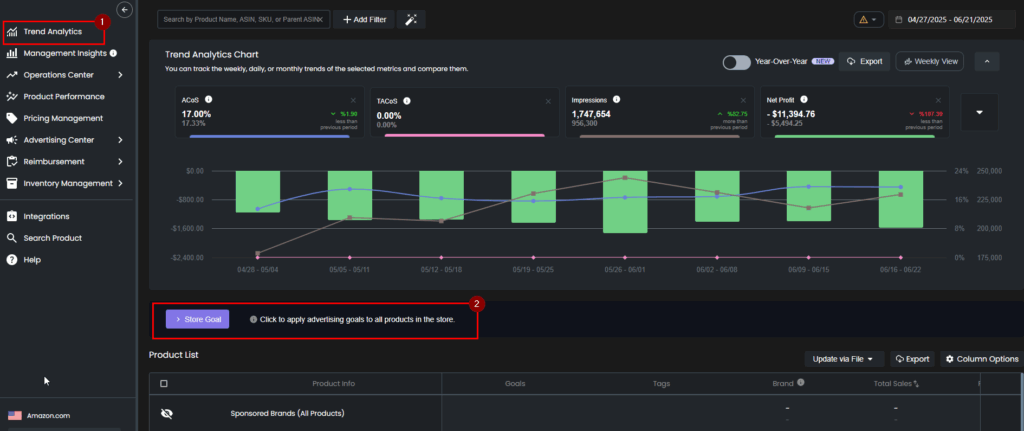
Let’s define each level!
🏬Store-Level Goals
Best for: Unified advertising objective across all products and brands within your store.
Store-level goals apply to all campaigns and brands under a single store. Use this level if your focus is on overall store performance—like boosting your total store profit or focusing on your sales growth. This goal should be set to all campaigns in a store without dividing multi-ASIN campaigns and single-ASIN campaigns.
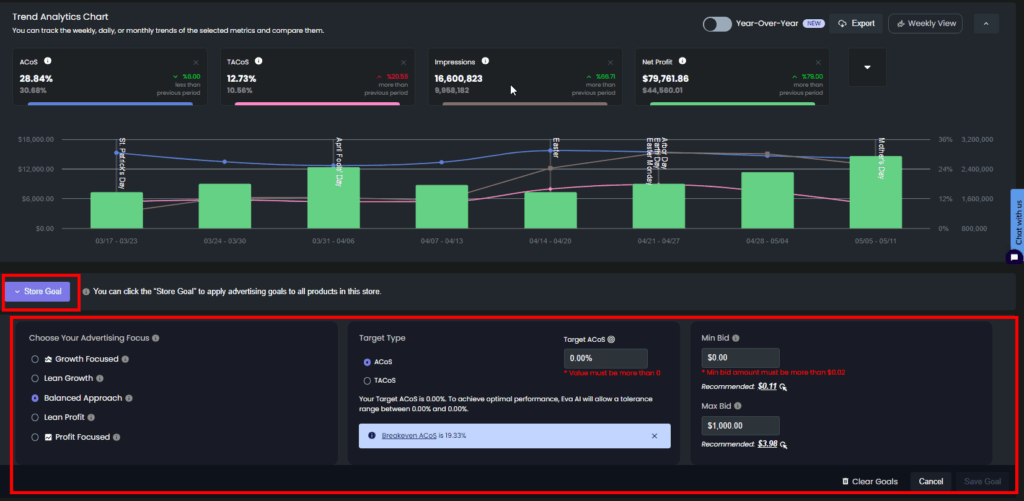
🔖Product-Level Goals
Best for: Businesses aiming to promote individual items with tailored messaging and performance targets.
Product-level goals apply to specific products or ASINs, allowing you to optimize campaigns based on the unique attributes and performance of each item. Use this level if your focus is on overall product performance—like boosting your total product profit or focusing on your product’s sales growth.
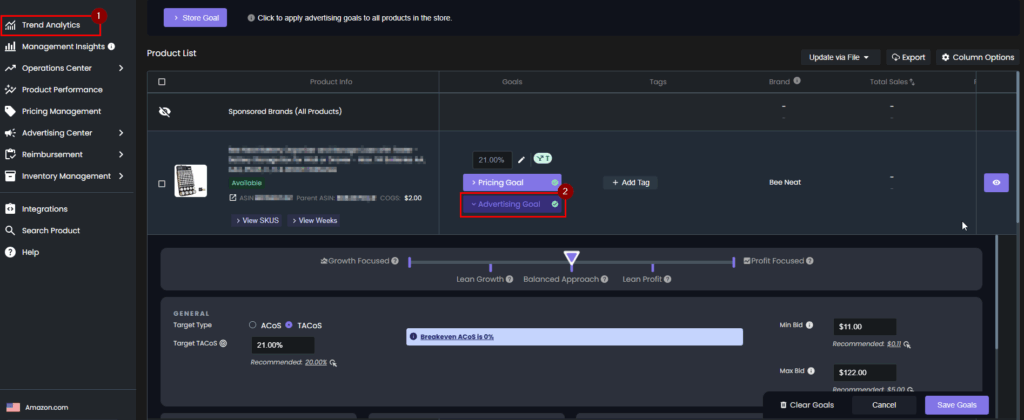
📣 Campaign-Level Goals
Best for: Targeting specific advertising outcomes at a granular level.
Campaign-level goals focus on a single advertising campaign. Use this level if your focus is on overall campaign performance—like boosting your total campaign profit or focusing on your campaign’s sales growth.
Note: The Campaign-level goals is still under development
Setting Your Advertising Goals
Think of this section as your guide to steering your advertising journey with Eva AI. The settings below shape how Eva AI understands and acts on your objectives. By learning how each one functions, you can confidently navigate toward your goals—whether you’re focused on scaling, maximizing profit, or striking the right balance. We’ll break down what each setting means and how to use them strategically to keep your path aligned with your business vision.
To achieve the best performance, we recommend that you start by setting your Store-level goals first and then manage the product-level/campaign-level goals if you will have different goals per product or campaign.
Please note that by default, settings at lower levels take precedence:
- Store-level settings apply to all lower levels (Product, Campaign) unless overridden.
- Product-level settings apply only to campaigns for that specific product (ASIN).
- Lower-level settings cannot be overridden by higher-level settings by default.
🎯Advertising Focus
You will start with setting your Advertising Focus. This setting lets you decide how Eva AI should optimize your ad spend strategy. You can decide to focus on whether you aim for rapid growth, maximum profitability, or a balanced approach that blends both goals.

These are the strategies you can choose:
- Growth Focused – if selected, Eva AI will prioritize aggressive ad spending to maximize revenue and sales, even if it sacrifices profitability
- Lean Growth – if selected, Eva AI will balance growth but with slightly reduced emphasis on spending
- Balanced Approach – if selected, Eva AI will balance the mix of growth and profit optimization
- Lean Profit – if selected, Eva AI will emphasize profit while still allowing some investment in growth
- Profit Focused – if selected, Eva AI will prioritize maximizing profitability by reducing unnecessary ad spending
Depending on your focus, you can move the slider to select which strategy Eva AI should prioritize.
📈Target Type
After setting your Advertising Focus, you will choose your Target Type. When setting up your AI optimization strategy, you’ll first choose your primary KPI—either ACoS (Advertising Cost of Sales) or TACoS (Total Advertising Cost of Sales). This selection helps the AI understand your business priorities and tailor its ad spend decisions accordingly:
- ACoS focuses on ad-attributed performance, ideal if you’re optimizing specifically for ad-driven sales.
- TACoS looks at ad spend in relation to total sales, offering a broader view of how ads impact overall business performance (only applicable for Store, Brand, and Product Levels).
You’ll also have the option to define a target percentage for your chosen KPI. This tells the AI what “success” looks like—allowing it to optimize ad spend while staying within your desired performance threshold.
By clearly setting both the KPI and its target value, the AI can effectively drive your campaign toward your specific growth or profitability goals.

💰Min. Bid/Max. Bid
Once you have decided on your Target, you will set your Min. and Max. Bids. This setting allows you to define both minimum and maximum bid limits, giving you greater control over your ad spend. By setting these limits, you can ensure that your daily budget is spent efficiently, preventing overspending while still optimizing for the desired results.

➖Minimum Bid (Min. Bid)
The Minimum Bid (Min Bid) is a hard cap that defines the absolute lowest Cost-Per-Click (CPC) bid our Eva AI is allowed to place on any of your targets (keywords, ASINs, etc.) within its scope (Store or Product level).
Why is it important?
While Amazon allows very low minimum bids (e.g., $0.02 for Sponsored Products in the US), allowing bids to drop this low can hinder the AI’s effectiveness.
- Slow Recovery: If a target starts performing better after its bid was reduced to the absolute minimum, it takes much longer for the AI to gradually increase the bid back to a level that can win impressions and clicks.
- Ineffective Spend Cutting: Bids near the absolute minimum often generate negligible impressions and clicks anyway. Setting a slightly higher floor makes the decision to “cut spend” on a target more decisive and impactful.
How does it work?
The AI constantly analyzes performance data to adjust bids. If performance dictates lowering a bid, the system will decrease it towards your target ACoS or goal, but it will stop decreasing once it hits the Min Bid value you’ve set. It will not go lower, regardless of performance.
Setting the Min. Bid:
- Store Level: The suggested Min Bid at the Store level is calculated considering the minimum viable bid across relevant marketplaces needed for effective spend cutting and quick recovery. This provides a sensible default safety net for all products unless overridden.
- Product Level: You can set a specific Min Bid for individual products or groups. The recommended default logic remains the same (balancing recovery speed and spend cutting), but you can adjust it based on unique product characteristics if needed. We generally recommend $0.11 for the US marketplace as a starting point.
➕Maximum Bid (Max. Bid)
The Maximum Bid (Max. Bid) defines the absolute highest Cost-Per-Click (CPC) that Eva AI can place on any target within your Store or Product-level settings.
Why is it important?
While Eva AI aims to optimize bids based on your goals, market conditions can sometimes lead to potentially high CPCs. The Max Bid serves several key purposes:
- Profitability Protection: Prevents high CPCs from wiping out margins, even during promising conversion periods.
- Budget Control: Shields against sudden cost spikes due to market changes or increased competition.
- Strategic Alignment: Ensures AI bidding remains within what you consider an acceptable risk range.
How does it work?
The AI increases bids based on performance, goal alignment, and auction dynamics, but will never exceed the Max Bid you’ve defined, regardless of performance signals.
Setting the Max. Bid
- Store Level: A default Max Bid is calculated using the highest average CPC across all targets in your store over the last 30 days.
- Product Level: You can override this using the product’s own CPC data. Align the Max Bid with your item’s price, margin, and ACoS targets.
Recommendation:
Review the suggested Max Bid. Consider your product’s price, profit margin, and target ACoS when setting this value. While the system suggests a value based on historical CPCs, you should adjust it to align with your specific profitability requirements.
↕️Optimizing Your Advertising Goals
After you have set all your KPIs and Targets, it is now time to optimize your goals! Boost your store’s efficiency and performance by fine-tuning how your ads function with powerful optimization tools. Here’s how each feature helps elevate your strategy:
- Daily Bidding: Automatically adjusts bids to align with your selected strategies, optimizing your ad spend for maximum impact.
- Dayparting: Pause ads during specific hours (e.g., 2:00 AM to 6:00 AM, based on marketplace time) to avoid unnecessary spend during low-traffic periods.
- Negating: Automatically filters out underperforming search terms to ensure your ads stay relevant and cost-effective.
- Ad-Status: Allows you to activate or deactivate ads for individual products based on their performance, ensuring you’re promoting only the top performers.
Control each feature effortlessly through customizable dropdown menus, tailoring actions to match your store’s unique goals and growth strategies.

You now need to select which option is best to optimize your advertising.
Daily Bidding
Modify your daily bid strategy by selecting either default or custom optimization settings to strike a balance between cost and performance.
- Optimized by Eva AI: Eva AI will automatically handle bidding with integrated optimization strategies.
- Don’t Optimize: No bidding adjustments will be made, and the system will not automatically alter bids.
- Custom Optimization: To learn about the custom optimization options, read here.

Dayparting
Enhance ad performance by timing your campaigns to run during peak conversion hours.
- Ads off during 2-6 AM: Your ads are automatically paused from 2 AM to 6 AM to avoid low conversion hours and reduce wasted spend.
- Don’t Optimize: If selected, Ads will run throughout the day.

Negating
Control ad spend on underperforming terms with tolerance-based keyword exclusions.
- Negating with High Tolerance: A cautious approach. Only search terms that show clear underperformance are negated, and the system waits for more data before acting.
- Negating with Medium Tolerance: A balanced strategy. Moderately underperforming search terms are excluded after sufficient data has been gathered and assessed.
- Negating with Low Tolerance: An aggressive method. Even slightly underperforming search terms are quickly excluded based on early performance indicators.
- Don’t Optimize: Disables automatic search term negation.
- Custom Optimization: To learn about the custom optimization options, read here.

Ad-Status
Boost efficiency by automatically pausing ads for out-of-stock products or those not meeting performance targets.
- Inventory Aware Product Pause (Excl. Inbounds): Pauses ads for products with low inventory, considering available and FC transfer stock, but excluding inbound inventory. Ads are re-enabled once inventory is replenished.
- Inventory Aware Product Pause (Incl. Inbounds): Pauses ads for products with low inventory, considering available, FC transfer, and inbound stock. Ads are re-enabled once total inventory is replenished.
- Performance Aware Product Pause: Pauses ads for products underperforming in advertising, without automatic re-enabling.
- Performance & Inventory Aware (Excl. Inbounds):Pauses ads for products with low available or FC transfer inventory, or those with poor performance. Products are not automatically re-enabled.
- Performance & Inventory Aware (Incl. Inbounds): Pauses ads for products with low available, FC transfer, or inbound inventory, or those with poor performance. Products are not automatically re-enabled.
- Don’t Optimize: Disables automatic ad-pausing, No performance-based or inventory-based rules will be applied to pause ads.
- Customize Optimization: To learn about the custom optimization options, read here.

📢Automatic Campaign Creation
Unlock the full potential of your campaigns with Eva AI! Let Eva handle campaign creation, optimizing your ad spend to boost sales and visibility. With Eva’s cutting-edge technology, you can focus on growing your business while we ensure your campaigns reach the right audience at the right time. Eva AI can independently schedule and create targeted campaigns to boost ad sales, expand reach, and increase market share.
To access the AI Campaign Creation, go to Advertising Center > AI Settings > AI Campaign Creation .
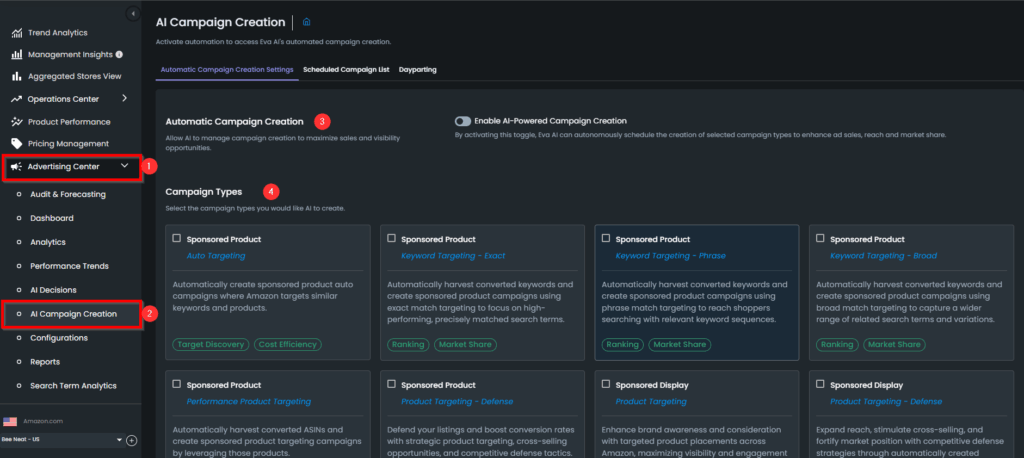
Campaign Types and the Settings
The first thing that you need to select is the campaign type that you want Eva AI to create for you:
- Sponsored Product (Auto Targeting): Automatically create auto-targeted Sponsored Product campaigns, allowing Amazon to target relevant keywords and products.
- Sponsored Product (Keyword Targeting – Exact): Automatically extract high-converting keywords and create exact match campaigns to target specific, high-performing search terms.
- Sponsored Product (Keyword Targeting – Phrase): Automatically extract high-converting keywords and create phrase match campaigns to reach shoppers using relevant keyword sequences.
- Sponsored Product (Keyword Targeting – Broad): Automatically extract high-converting keywords and create broad match campaigns to capture a wider range of related search terms and variations.
- Sponsored Product (Performance Product Targeting): Automatically identify and target high-converting ASINs to create product-targeted Sponsored Product campaigns.
- Sponsored Product (Product Targeting – Defense): Protect your listings and increase conversions through strategic product targeting, cross-selling, and competitive defense tactics.
- Sponsored Display (Product Targeting): Enhance brand visibility and consideration by targeting relevant products across Amazon, boosting engagement opportunities.
- Sponsored Display (Product Targeting – Defense): Expand your reach, promote cross-selling, and defend your market position with strategic product targeting in Sponsored Display campaigns.
- Sponsored Display (Audience Targeting): Automatically create auto-targeted Sponsored Display campaigns where Amazon targets keywords and products similar to the ones in your ad.
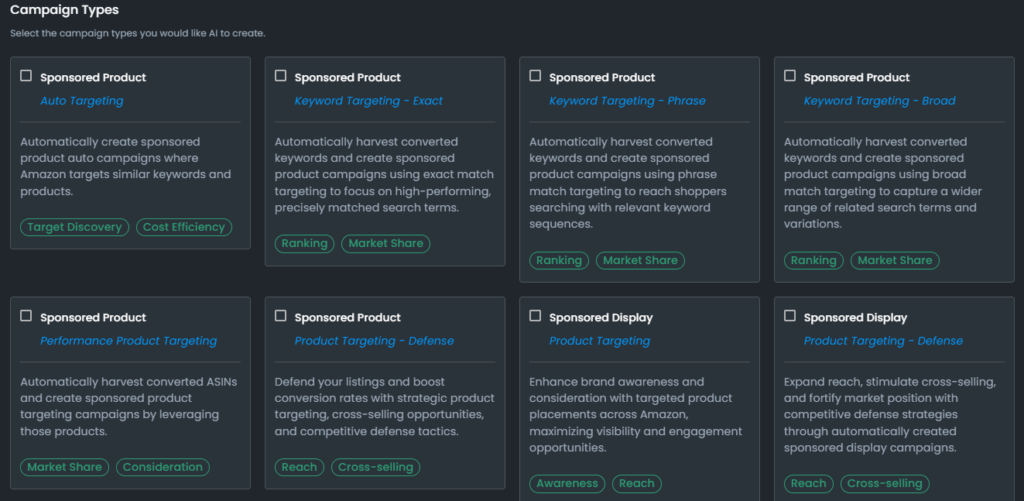
Once you have selected your preferred campaign type, you now have to set the following information:
- Total Daily Budget
- Schedule Auto Campaign Creation
- Select Advertised Products
- Exclude Branded Keyword (if you wish to prevent Eva AI from including brand-related keywords in automatically created campaigns)
- Add Branded Keyword List
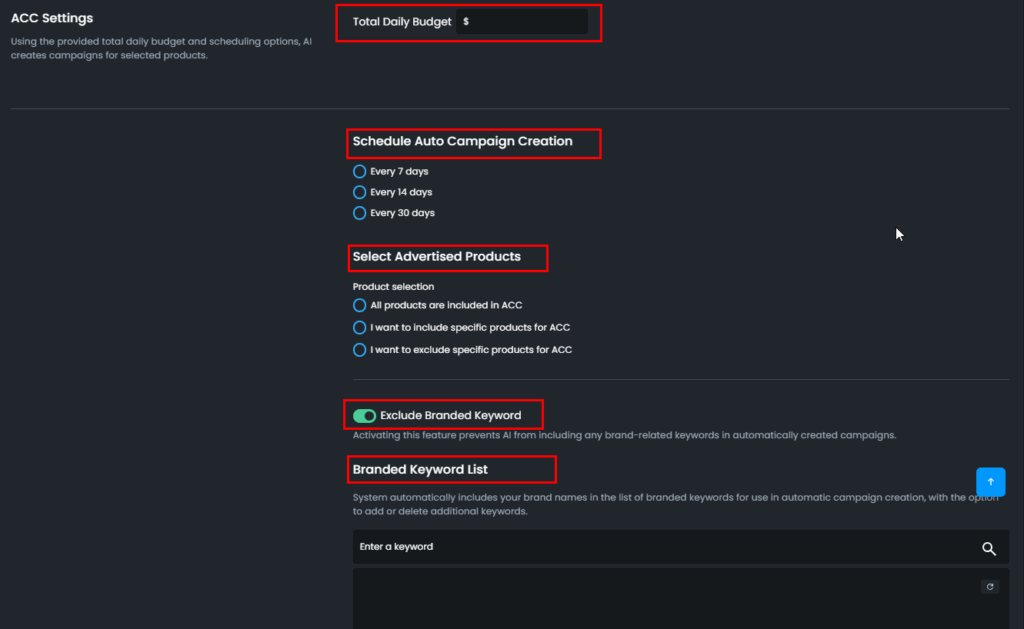
Once everything is set, you are now one step away to achieving more Amazon success!
“Ready to Elevate Your Success? Schedule a call with our experts today – simply click this link and choose a time that works best for you!”
